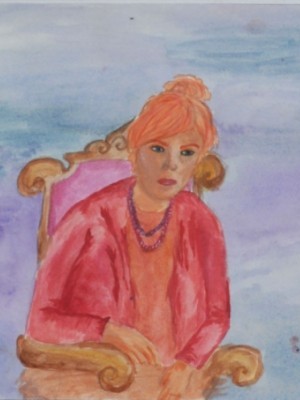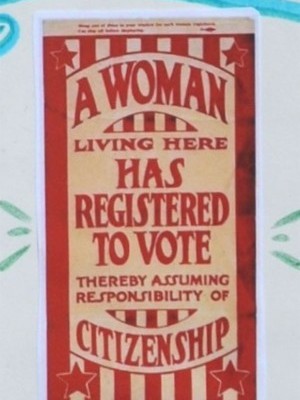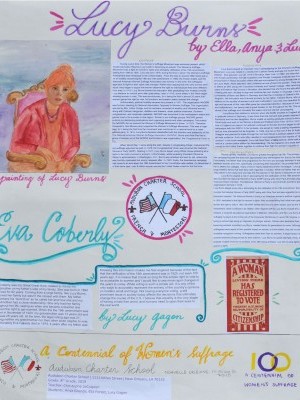Lucy Gagon, Anya Grenda & Ella Forest
Audubon Charter School | New Orleans, LA | 8th Grade
Historical Figure I Admire
Lucy Burns
LUCY BURNS' BIOGRAPHY by Ella Forest
Lucy Burns played an important role in campaigning for the Women’s Suffrage Movement. Lucy was raised in a strictly Irish Catholic family and was the fourth of eight children. She was born July 28, 1879 in Brooklyn, New York. In 1880, she attended what was then known as Brooklyn Female Academy (now Packer Collegiate Institute) and thrived in its environment of liberal education where she was surrounded by strong female role models such as Laura Wylie. Wylie attended Yale University and Vassar College. After teaching for two years at Erasmus High School in Brooklyn, she decided that she found the education field irritating and soon decided to stop and continue her own studies in language. Lucy attended the Universities of Bonn and Berlin in Germany and then the University of Oxford in the United Kingdom. Her education was financed primarily by her father, Edward Burns, who was a strong believer in equality of women’s and men’s education. Lucy was very beautiful from a young age and because of this, men often gave her unsolicited attention. Because of men’s disrespect and maltreatment, her beauty was a great burden on her throughout her life. This was the main cause of her suffrage and ultimately the reason she first started campaigning.
LUCY BURNS' CONTRIBUTION TO THE MOVEMENT by Anya Grenda
Society greatly impacted Lucy Burns throughout her life. The primary reason for her campaigning was the way men appropriated and stereotyped her due to her looks. Fortunately, her father was very progressive for the time and strongly believed in equality between women and men, specifically concerning their education. He provided the funding for her to attend six colleges, many of which highly esteemed and/or Ivy league. Lucy grew up in large wealthy family that was fairly well regarded in society. While her father was progressive, they weren’t very close and she was the first woman in their family to become an activist.
Lucy played a role in advocating for the ratification of the 19th amendment. Burns also founded the National Women’s Party (NWP) along with Alice Paul and was arguably its most prominent member. The National Woman’s Party is an American woman’s political organization formed in 1916, dedicated to the fight for women’s rights. After accomplishing their initial main goal of granting women the right to to vote in 1920, the NWP shifted their focus to other issues, such as the Equal Rights Amendment, which is still yet to be ratified. Other legacies left by Lucy Burns include the Lucy Burns Institute, a nonprofit educational organization in Madison, Wisconsin, and the Lucy Burns Museum, a suffragist museum at the former site of the Occoquan Workhouse in Laurel Hill, Virginia.
A huge part of being an activist was being an inspiration to younger women. Women who dedicated their lives to becoming activists, including Lucy Burns, created history for generations to come. Although the incredible recognition was coming, suffragettes risked their lives for activism. Lucy Burns is a great example of this, for she was arrested multiple times for her protests. Even after being arrested, Lucy did not stop fighting for women’s rights.
Lucy Burns first dabbled in activism when she briefly traveled to England while enrolled in graduate school in Germany. It was there that she met and was greatly inspired by Emmeline Pankhurst and her two daughters. Burns ended up quitting graduate school to live with the Pankhursts and work in the Women’s Social and Political Union from 1910 to 1912. During her time in England, her passion for activism continued to flourish and she began to participate in campaigns with the WSPU. In her protests, she aimed to make a lasting impression on people and be sure she would not be forgotten. In 1909, she hid on the roof of the St Andrews Hall in Glasgow and planned to break through the roof and disrupt a political speech in front of an all-male audience. Such acts often resulted in court appearances and reports of “disorderly conduct” in the local newspaper.
Lucy met Alice Paul, a fellow activist, while both were being held at a London police station for demonstrating. The two became very close and eventually moved to the United States together to continue their fight for women’s equality in 1912.
Inspirational Family Member
Eva Coberly
Eva Coberly was my great-great-aunt, related to me by my grandmother on my father’s side of my family. She was born in 1892 and lived for 82 years. Coming from a large family like Lucy Burns, she loved her family but wasn’t the closest with them. My father remembers his “Aunt Eva” - as he called her - and how she and my Grandmother had a close relationship. She only had her family throughout life. When she became a teacher she revoked the right to be married. When the 19th Amendment was ratified in November of 1920 my grandmother was 13 years old and Eva was 28 years old. At the time, the legal voting age was 21, making neither my grandmother nor her other sisters eligible to vote. –Lucy Gagnon
What the Project Means to Me
Unfortunately Eva Coberly died in 1974, 4 years after my father was born. Knowing this information makes me feel angered because of the fact that the ratification of the 19th amendment was in 1920, not even 100 years ago. It is insane that it took so long for the simple right to vote to be accessible to women and I would like to see more rapid changes in the year to come. While voting is such a simple act, it is one of the only ways to accurately represent the entirety of the country’s opinions on matters small and large. Not having every one voting, a still prominent issue in society today, affects the decisions that ultimately change the course of the US. I believe that equality is the very staple of having a hate-free world, and humans need to open their eyes to the real world.
Explore the Archive
More From This Class
Click on the thumbnails below to view each student's work.Deadline Extended
There's still time to join Women Leading the Way.
Become a part of our storytelling archive. Enroll your class today.
Join the Project





